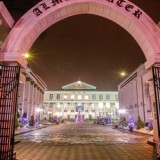Spiritual education of youth through museums
As is known, modern society requires people who are not only enterprising but also intelligent and highly educated, that is, specialists who can understand the universal value of cultural heritage. The center of this system is a person who was brought up and developed in a multicultural space. Of course, this should happen from an early age, in our case, from the first year of university. The sharp rise in national self-awareness observed in recent years and the desire for ethnocultural self-identification determine the enormous interest of people in both their own national culture and the culture of other peoples in their immediate and distant surroundings. In this situation, searching for and using effective approaches to educating young people in multinational communities becomes a pressing issue.
Museums have a unique ability to influence the intellectual-volitional and emotional processes of the individual, and each exposition, and exhibition represents an original program of transmission through exhibits of certain knowledge, skills, judgments, assessments, and feelings. For example, in many countries museums are officially included in the system of continuous education, which provides for the acquisition of knowledge over a long time.


Almaty Museum and the State Museum of Arts of the Republic of Kazakhstan named after A. Kasteev. Students of groups ТФП23-018к and ОМ24-014к with teachers of the Department of Chemistry Kunkozhaeva G.K. and Begimova G.U.
Thus, the museum’s educational space allows to preserve and, what is especially important, cultivates patriotic feelings of youth. It is necessary to note the role of the museum of our university in the education of student youth, in introducing them to the traditions of the university. Students’ access to museum relics allows students to look at past events, previously known to them only from history textbooks, from new positions. The university museum allows them to study the real life of students and teachers who studied and worked at the university during the years of its formation, development, and growth. It is in the museum that the “connecting thread of time” is realized, a kind of dialogue between generations takes place when young people try on the events and deeds of the past in order to learn to live with dignity today.

A new exhibition in the State Museum of Arts of the Republic of Kazakhstan named after A. Kasteev on the theme of the periodic table of chemical elements
In our opinion, museum excursions, talks, and lectures have an enduring significance for the civic-patriotic education of youth based on historical traditions and should be accessible not only to students of this university but also to schoolchildren, which will help them in the matter of choosing a profession.










